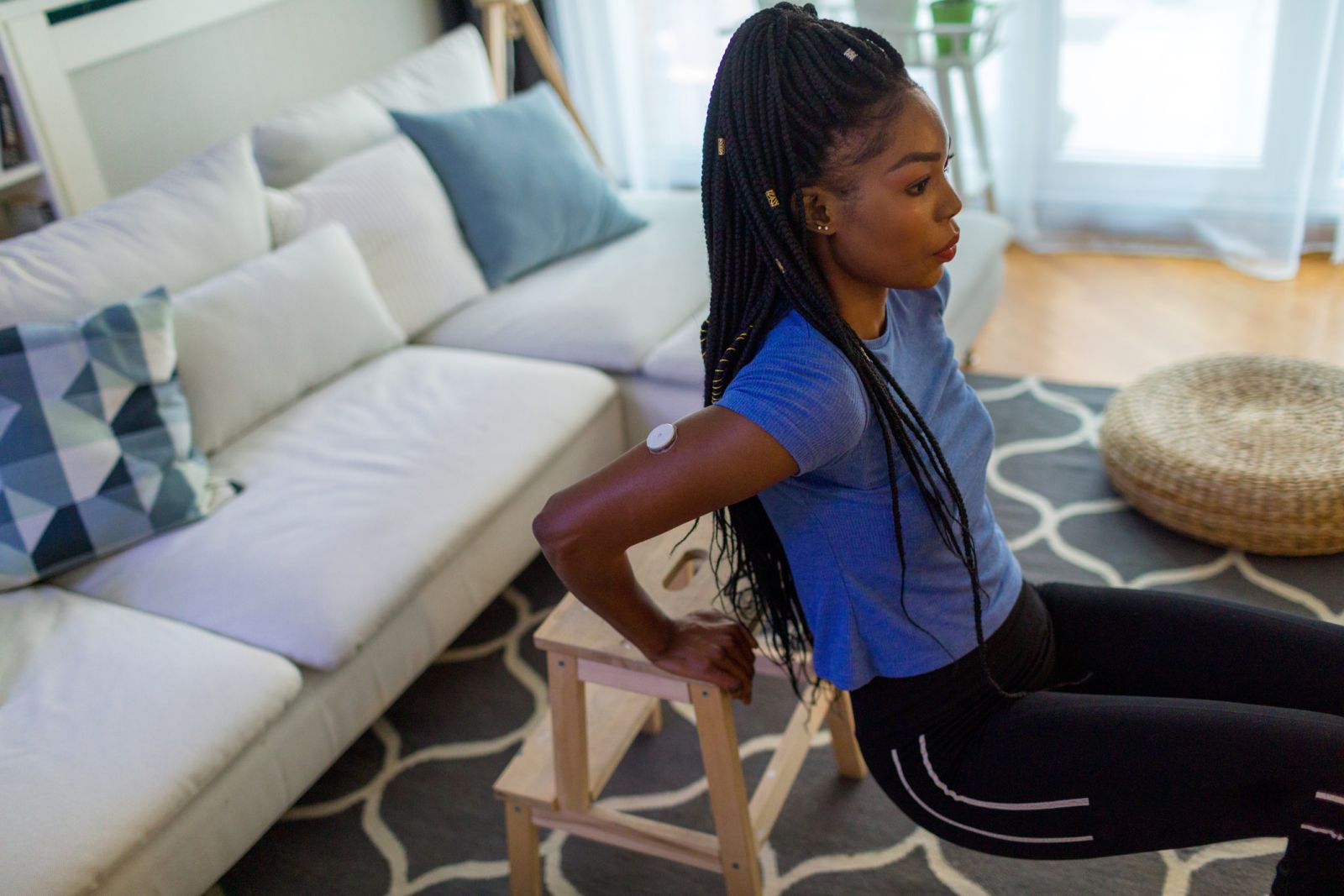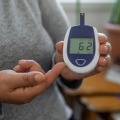6 Tips To Fit ‘Exercise Snacks’ Into Your Day
By April Hopcroft
 Exercise snacks – short bursts of physical activity – can improve glycemic control and boost cardiovascular fitness. Experts share tips on how to incorporate exercise snacks into your daily routine.
Exercise snacks – short bursts of physical activity – can improve glycemic control and boost cardiovascular fitness. Experts share tips on how to incorporate exercise snacks into your daily routine.
When you hear the words “exercise snacks,” you may think of a smoothie, a piece of fruit, or a protein bar. But exercise snacks aren't about what you eat or drink pre- or post-workout. Think about them as bite-sized bursts of exercises – like jumping jacks or climbing stairs – you can easily fit into your day.
It’s especially important to be physically active if you have diabetes to reduce your risk of heart disease. Yet, many people struggle to meet the American Diabetes Association’s weekly exercise targets, which recommend at least 150 minutes of moderate-intensity exercise each week. According to the CDC, less than 50% of people with diabetes met these recommendations for physical activity.
Work schedules, childcare duties, and transportation barriers are just a few factors that can complicate efforts to squeeze in a dedicated workout session. Not to mention those pesky high or low blood sugar episodes that get in the way of even the best-laid plans to exercise.
New research suggests that short bouts of physical activity could deliver some of the same benefits – like improved heart health and blood sugar control – as longer exercise sessions. Here’s what exercise snacking looks like and our top tips for getting started.
What are exercise snacks?
You can turn almost any form of physical activity into an exercise snack, but some common examples include:
-
Climbing stairs
-
Jumping jacks
-
Jumping rope
-
Bodyweight exercises like push-ups, lunges, or squats
-
Brisk walking
These exercise snacks are usually done several times a day. This means going hard for 30 to 60 seconds and aiming for a moderate effort level, said Jonathan Little, professor in the School of Health and Exercise Sciences at the University of British Columbia.
“It doesn’t need to be all-out. But because exercise snacks are so short, you do have to put some effort in,” Little said. If measuring perceived effort on a scale of one to 10, Little suggests starting at a five and gradually ramping up to a seven or eight.
 Because exercise snacks are so short and don’t need to be done at a gym, they offer the ideal solution to many common barriers to physical activity, like time and transportation constraints. However, exercise snacks shouldn’t replace all physical activity and are not as well understood as longer durations of physical activity, Little said.
Because exercise snacks are so short and don’t need to be done at a gym, they offer the ideal solution to many common barriers to physical activity, like time and transportation constraints. However, exercise snacks shouldn’t replace all physical activity and are not as well understood as longer durations of physical activity, Little said.
“Although exciting, we don’t yet have a robust body of literature to support exercise snacks for improving a variety of health outcomes like we have for more traditional forms of exercise,” he said.
Ideally, these shorter bursts of exercise should form part of your lifestyle, in tandem with a few longer sessions.
Who are exercise snacks for?
Anyone with (or without) diabetes can benefit from incorporating short bursts of exercise into their daily routine.
If you’re new to exercise
Getting regular exercise can feel intimidating, especially if you’re new to it, which is why smaller workouts like these can be a great starting point.
Setting bite-sized realistic goals – such as completing exercise snacks several times a day – is a great way to work towards establishing a regular exercise routine, said Sarah Hormachea, a registered dietitian and certified diabetes care and education specialist (CDCES) at Nourish. These types of “SMART” goals tend to be more achievable than larger, vague objectives.
“Exercise is good wherever you can get it in,” Hormachea added. “When you lower the bar of what constitutes a workout then it’s much easier to make it happen.”
If you find it hard to make time for exercise
 Parents, caregivers, and other people who face social or psychological barriers to physical activity can also benefit from exercise snacks. Microbursts of exercise are typically much easier to weave into your lifestyle, as they can be more spontaneous and flexible.
Parents, caregivers, and other people who face social or psychological barriers to physical activity can also benefit from exercise snacks. Microbursts of exercise are typically much easier to weave into your lifestyle, as they can be more spontaneous and flexible.
Knowing that you can still reap benefits from brief exercise snacks may encourage people to squeeze in some physical activity on days when life gets in the way of doing a longer dedicated workout.
“Releasing yourself from the idea that exercise needs to look a certain way in order to ‘count’ is important,” said Robin Arzón, vice president of fitness programming and head instructor at Peloton who lives with type 1 diabetes.
For people with limited time to exercise, Arzón suggested replacing the statement “I don’t have time” with “it doesn’t matter.”
“Often, we're going to do what we make time for,” she said. “And if you only have five, 10, or 15 minutes, then you have five, 10, or 15 minutes and you should do something with that.”
If you’re struggling to manage high blood sugar
From a glucose management standpoint, Hormachea said there are immense benefits to brief periods of quick, simple exercises or activity, especially as a tool to treat high blood sugar.
Exercise snacks could be particularly helpful for people with type 2 diabetes who only take oral medications. For those not on insulin, there aren’t many tools available to manage blood glucose besides drinking water, eating a healthy diet, and exercising. Thus, Hormachea suggests thinking of exercise snacks as a “therapeutic tool” to reduce post-meal spikes in blood sugar.
For people with insulin-dependent type 1 or type 2 diabetes, exercise snacks can serve as an alternative to taking a correction dose for high blood sugar.
“Any time you take insulin, you have an inherent risk of low blood sugar, which can be an overwhelming burden,” Hormachea said.
How do exercise snacks affect diabetes management?
Traditional exercise has long been known to promote insulin sensitivity in people with and without insulin resistance. Studies have found short bouts of vigorous activity have been shown to improve fitness and increase markers of insulin sensitivity.
Exercise snacks can also improve blood sugar levels, particularly if the activities are done after meals. For instance, Little and his colleagues found that stair-climbing – about three flights, or 30 seconds of ascending the stairs as quickly and safely as possible – reduced postprandial insulin levels in people at risk of developing type 2 diabetes.
Ginger Vieira, author of “Exercise With Type 1 Diabetes,” has lived with type 1 for 25 years and said exercise has been a powerful strategy to improve her insulin sensitivity. In her teenage years, she was taking 30 units of long-acting insulin each day to manage her diabetes. However, Vieira wasn’t paying attention to diet or exercise and “felt totally out of touch with her health.” Fast forward many years, Vieira now exercises regularly and needs just 10 units of insulin each day.
“I could easily need three times as much long-acting insulin if I didn’t exercise every single day,” she said. For context, Vieira’s exercise routine includes twice-daily dog walks, some running or cardio, and a “teensy” bit of weights – nothing too intense.
Be sure to consult with your healthcare provider or physical therapist to figure out what kinds of exercise snacks would be most appropriate for your needs.
Other health benefits of exercise snacks
 Exercise snacks are a particularly valuable way to get moving during the day, especially for those working desk jobs. Sitting for long periods has been linked to an increased risk of cardiometabolic disease and death, with some researchers even suggesting that sitting is the new smoking (however, don’t forget all the problems caused by smoking, especially if you have diabetes).
Exercise snacks are a particularly valuable way to get moving during the day, especially for those working desk jobs. Sitting for long periods has been linked to an increased risk of cardiometabolic disease and death, with some researchers even suggesting that sitting is the new smoking (however, don’t forget all the problems caused by smoking, especially if you have diabetes).
Indeed, studies have found breaking up periods of sitting with short bursts of light or moderate-intensity walking reduces postmeal glucose and insulin levels in people with obesity. Brief bouts of activity have also been shown to improve triglyceride levels in adults with type 2 diabetes.
Beyond supporting heart health, short bursts of exercise may also be good for your brain and overall mood. Research shows that as little as 10 minutes of consecutive exercise can lead to increased brain volume, a possible sign that exercise has neuroprotective benefits.
How to fit exercise snacks into your daily routine
As a starting point, it’s important to recognize that we’re a product of our environment, Hormachea said. For instance, people who live in the suburbs typically rely on cars to get around and may not have a reason to go for a walk. With this in mind, you may need to do some “engineering” of your environment and routine to incorporate more physical activity.
Above all, experts advocate for choosing a form of movement you enjoy doing – whether that’s walking, dancing, or lifting weights. Vieira noted that exercise snacking can apply to both cardio and strength.
“What’s most important is to be engaging muscle and making sure we’re not losing muscle,” she said.
1. Consider insulin on board
For anyone with insulin-dependent diabetes, Vieira said it’s important to recognize that there is a risk of hypoglycemia anytime you exercise with insulin on board (insulin that is still working in your body from earlier doses). Be sure to check your blood sugar regularly if you’re not already using a continuous glucose monitor (CGM) and be mindful of insulin on board.
While there are clear guidelines for insulin dosing for longer exercise sessions, Hormachea said it could be harder to plan for exercise snacks since they’re so short. Learning how to dose properly for exercise snacks may require some trial and error, she noted.
“You may want to be a little more conservative in insulin use if you want to get to a point where you’re doing many microbursts of exercise throughout the day,” Hormachea said. That is, you may want to consider using less insulin and monitoring the effect of exercise on glucose levels more carefully.
Vieira said she is also a big fan of fasted exercise (for example, exercising first thing in the morning on an empty stomach) as a way to reduce concerns about insulin on board during physical activity. If you struggle with lows during exercise, you may want to consider fasted exercise. Meanwhile, if you struggle with highs after eating, then time your exercise snacks after meals before your blood sugar starts rising.
2. Engineer exercise snacks into everyday tasks
 It’s easier than you think to start incorporating exercise snacks into your daily routine. For example, challenge yourself to take the stairs instead of the elevator, Little said. When you take the stairs, try to ascend them as quickly as you can (safely).
It’s easier than you think to start incorporating exercise snacks into your daily routine. For example, challenge yourself to take the stairs instead of the elevator, Little said. When you take the stairs, try to ascend them as quickly as you can (safely).
Likewise, choose to park your car at the far end of the parking lot and walk briskly to the store. Or, get off the bus or train a few stops early so you build in an extra walk. If you work from home, consider building in a “reverse commute” walk at the start and end of each day to get your steps in.
3. Pair an exercise snack with transitions in your day
Taking a lesson from habit stacking, Little suggested pairing brief physical activities with specific parts of your routine.
For instance, every time you refill your coffee, take a bathroom break, or move between meeting rooms, do a whole-body exercise like marching or running in place, body weight squats, or jumping jacks.
4. Try a post-meal exercise snack
While more vigorous activities like running or dancing might not feel great on a full stomach, brisk walking still delivers many of the same benefits. Taking a quick walk lowers blood sugar, is easy (and free) to do, and helps you get fresh air and clear your head.
Little’s team is currently investigating the effects of performing an exercise snack 30 minutes after every meal.
“This might be a simple way to tell your muscles to take up some sugar from the blood and help smooth out your glucose spikes,” he explained.
5. Put on your favorite tunes for extra motivation
“Choose your favorite song right now and just dance,” Vieira said. “What could bring more joy?”
In addition to simply making workouts more fun, music has been shown to improve exercise performance and effort. Plus, a two or three-minute song is the perfect amount of time for a brief exercise snack to deliver a midday motivation boost.
6. Keep some dumbbells or resistance bands at your desk
 Many of us spend 40 hours or more sitting at a desk each week. Whether you go into the office each day or work from home, an easy way to incorporate exercise snacks into your workday is to make your environment more conducive to physical activity.
Many of us spend 40 hours or more sitting at a desk each week. Whether you go into the office each day or work from home, an easy way to incorporate exercise snacks into your workday is to make your environment more conducive to physical activity.
If it’s hard to get out for a walk up the stairs or around the block, consider what you can do at your workstation. A few dumbbell curls or resistance band squats can go a long way, Vieira said.
The bottom line
Exercise snacks are a great way to incorporate more movement into your daily routine and improve diabetes management.
Think of exercise snacks as a tool to meet physical activity recommendations and enhance cardiorespiratory fitness. They can be especially helpful for people who face barriers to conventional forms of physical activity whether due to cost, time constraints, or other factors.
While more research on exercise snacks is needed, it’s encouraging to see official guidelines that recognize the benefits of shorter bursts of activity. For instance, guidelines from the Office of Disease Prevention and Health Promotion and the World Health Organization have removed the requirement that physical activity should last at least 10 minutes.
“We need to let go of the idea of a workout that has to be this hour-long, intense CrossFit thing,” Vieira said. “You can get the benefits from any movement.”
“Doing something consistently is what the long movement game is about,” Arzón said. “I think that we should start rewarding consistency over this prepackaged idea of intensity or what a workout needs to look like.”
Learn more about exercise and diabetes:







